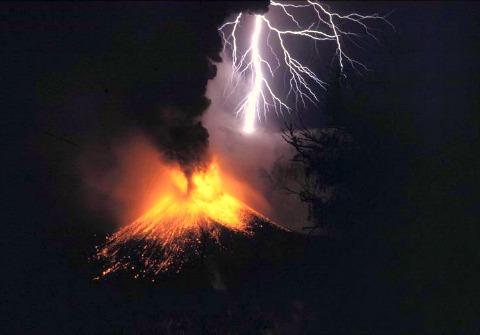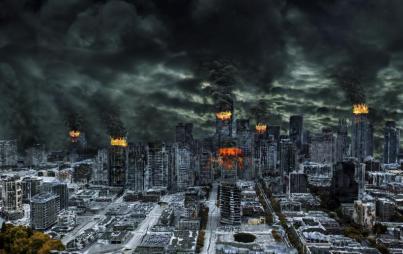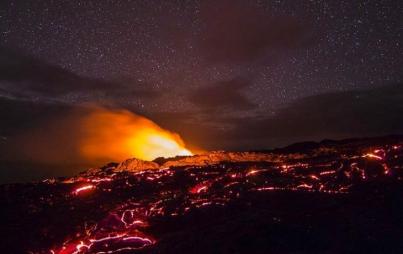
Think back to your high school history classes. Remember the goings-on of the early 1800s? Perhaps, if you rattle the cob-webby cockles of your mind you might recall the Louisiana purchase (which doubled U.S. territory), Napoleon’s final defeat in the Battle of Waterloo or even the Industrial Revolution.
But we bet you’ve never heard of the volcanic eruption of Tambora, eh? Us neither. But it turns out the 1815 explosion of this Indonesian time bomb was the most epic eruption on Earth in thousands of years, and spawned a whole series of major historical catastrophes thereafter. Tambora was a big effing deal.
The initial event itself caused a death toll of about 100,000 in the nearby area from lava (that's right—death by lava isn’t simply an invention of Hollywood), and the resulting tsunami nearly vanquished nearby coasts. Thick ash blanketed Southeast Asia, plunging the region into a week-long darkness in what was probably a lucrative time for local shamans. And that’s just the immediate effect of the natural disaster—Tambora had so, so much more to accomplish the world over, leaving an impact that lasted right through the end of the 19th century.
As we approach Tambora’s bicentennial anniversary next year (!), modern science and archival research have come together to cement the volcano’s place as one of the biggest environmental disasters ever. Here are three of the critical worldwide effects of the eruption.
Disease
When it wasn’t churning out lava, Tambora was releasing enormous quantities of sulfate gases, which screwed with the chemical equilibrium of the atmosphere. The atmosphere is pretty finicky, you see, and if thrown off balance it generally, goes nuts. For two years the sulfate impeded the largest weather system in the world—the Indian monsoon—from developing in time to yield much-needed rain on the subcontient. Most notably, severe drought (followed by late flooding) altered the environment of a festering cholera colony in the Bay of Bengal, creating a new, mutated, uber deadly strain!
The local population had no immunity to this monster cholera, and the bacteria happily hopped from victim to victim across Asia, and ultimately the globe. So on top of the initial 100,000 victims, we can add an additional tens of millions that died from the Bengal cholera by the end of the century. Black Death packed a real punch on 14th century society in Europe and East Asia, and this cholera strain likewise shaped the 19th century. Modern medical science and public health institutions largely got their start in response to the mutant cholera frenzy.
Agriculture
The drought from late monsoons in the Indian subcontinent also slashed crop yields all across the region. In China, a large southern mountainous province was plunged into icy cold weather and flooding rains which nixed rice crops. Some desperate, food-deprived villagers even killed their children to spare them the slow misery of death by starvation. Determined to avoid such disaster in the future, local farmers took up a more reliable cash crop—opium (the source of heroin). Yes indeed, Tambura succeeded in initiating the so-called “golden triangle” of international opium production between China, Burma and Laos that has since confounded authorities the world-over.
As for the old U.S. of A.? In 1816 our forebears went through the “Year Without a Summer” in which storms with dumped snow all along East Coast in June, resulting in the shortest growing season on record. It also ultimately triggering the first major economic depression in the U.S.—the Panic of 1819. (Thomas Jefferson even commented that “[n]ever were such hard times” for ordinary Americans).
Arctic Exploration
But no, Tambora still wasn’t done wreaking havoc on the planet. Having reached most continents, it set its sights on the poles. The eruption also changed wind circulation patterns and ocean currents, which led to a drastic warming of the Arctic. And as we’ve discussed previously, while enacting plenty of negative side effects, melting ice does have its advantages. In this case, the British Admiralty used the de-icing opportunity to chase an elusive sea-folk dream they'd been after since Elizabethan times: the sacred northwest passage for shipping to the East.
In 1817 Britain launched a (disastrous) campaign to chart the passage, not realizing that the Arctic melt would last no longer than three years. In fact, the region refroze just in time in 1818 to dramatically shorten the first major polar expedition in ages—probably a life-saving, if deeply unpopular move (what with the emphasis on Arctic heroism and all that). It took awhile for Brits to accept the renewed frozen reality of the passage, though British exploration finally came to an end in the 1840s with the tragic disappearance of the Franklin expedition, when all hands were lost.
(Funny enough, just recently global warming has again melted enough ice in the passage to tentatively open it to trade!)
So why isn't Tambora a major focus of history education? Blame human hubris that natural events don't affect us that much. We're good at spotting localized effects of Mother Earth, but when it comes to the big picture, it seems that we're just starting to catch on.
Image: commons.wikimedia.org.






